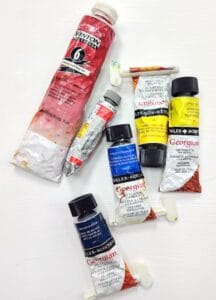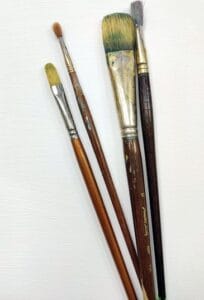My advice here is the same as it is for acrylic paintings. You don’t need to go out and buy tons of paints. Keep it simple. To start off you’ll need red, blue, yellow, black and white. Having just these colours in both warm and cool versions will offer you huge versatility. Warm colours include cadmium red, cadmium yellow and ultramarine blue. Cool colours include magentas, lemon yellow and phthalo blue. Your local art shop should be able to point you in the right direction if you can’t find what you’re looking for. My best advice here is to buy quality paint. Learn with fewer tubes of great quality products and you will get better results.
Hogshair brushes are generally used for oil painting because they are very durable, and they hold lots of paint. Using palette knives is a great alternative and makes cleaning up a whole lot easier.
 You will need to use solvents. They thin the paints and mediums plus you will need them to clean your brushes. Due to their toxicity, I would avoid classic thinners or turpentine but there are so many to choose from. Gamsol is considered by many artists to be the best; other products are available.
You will need to use solvents. They thin the paints and mediums plus you will need them to clean your brushes. Due to their toxicity, I would avoid classic thinners or turpentine but there are so many to choose from. Gamsol is considered by many artists to be the best; other products are available.
Linseed oil is another product you will need to use to thin down the paint, making application to the canvas smoother and, when required, more transparent. See my previous blog about preparing your canvas for oil painting.
In oil painting, it’s important to follow the “fat over lean” rule. This means that later layers of paint should have a higher oil content than earlier ones to help prevent cracking. So, start out by thinning your paint with solvents for the under painting and the first couple of layers of paint to establish your base tones. Then, as you add more, increase the amount of linseed oil you use in subsequent layers.
For glazing to create transparent, reflective effects, use thin, oil-heavy layers of paint. For impasto use thick layers.
Oil paints take time to dry. Patience is required here as you need each layer to dry before adding the next or you run the risk of your paint cracking. Some mediums like Liquin mixed with your oil paint can speed up drying times by up to half, according to the makers.
So now, play. The more you play with your materials the better you will get to know them and appreciate what you can achieve using them.
Do remember to clean your brushes or store them in a pot of solvent if you are not leaving long between using them. Put your paints away in a cool space.
NB, I do not get paid to endorse any people or brands mentioned in my blogs.
If you enjoyed this post, please like, share and follow me. Sharing, liking and following raises the algorithms in my favour.
Thank you for your support.

1 Comment.
Love your posts, I will begin artwork later this year